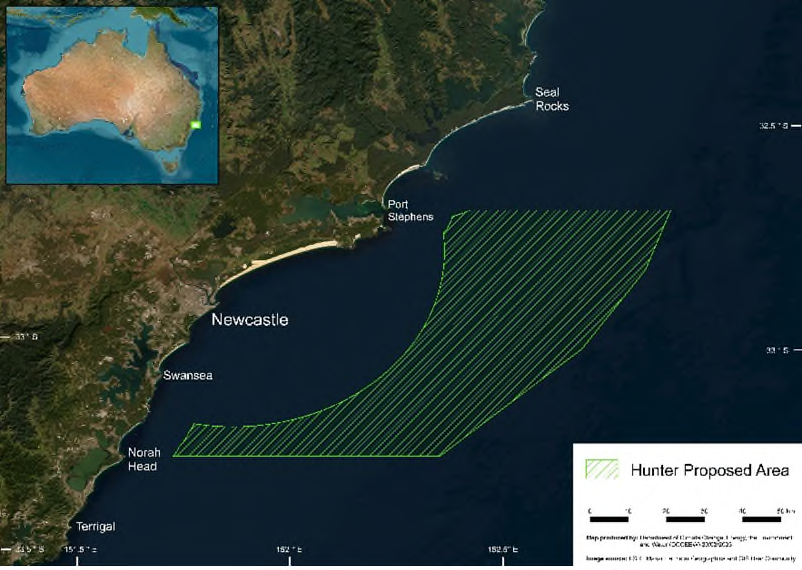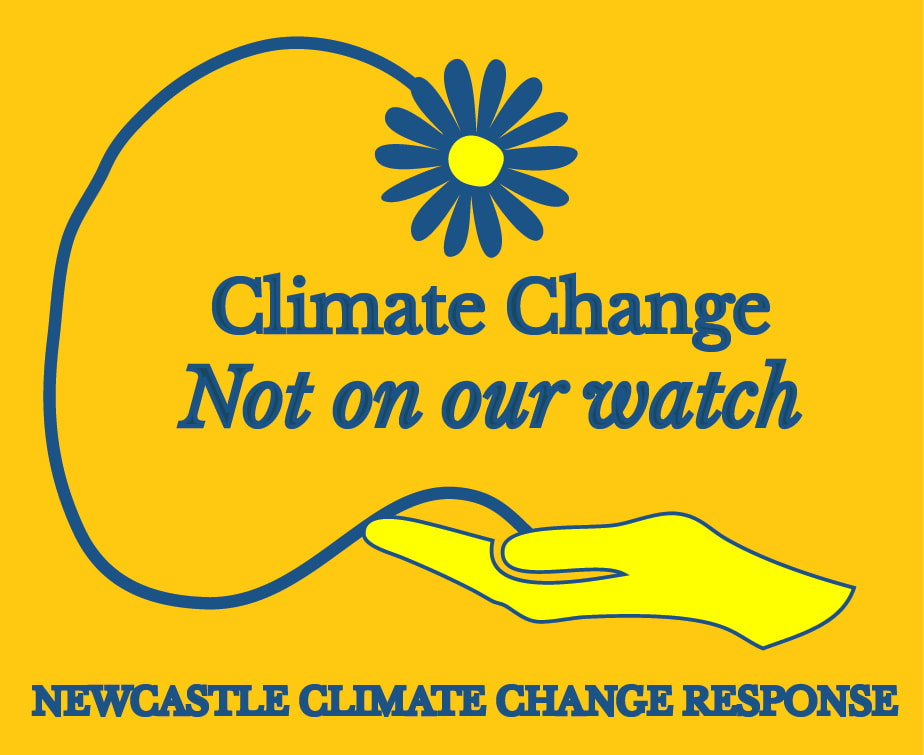Offshore renewable energy infrastructure area proposal: Pacific Ocean off Hunter Submission from Newcastle Climate Change ResponseOffshore Renewable Energy Section
Department of Climate Change, Energy, the Environment and Water [email protected] 27 April 2023 To whom it may concern Offshore renewable energy infrastructure area proposal: Pacific Ocean off Hunter Submission from Newcastle Climate Change Response Thank you for the opportunity to provide a submission into the Offshore renewable energy infrastructure area proposal: Pacific Ocean off Hunter and taking the time to consider our submission. Newcastle Climate Change Response (NCCR) strongly supports offshore renewable energy development in Australia, and the designation of the Offshore Renewable Energy Area in the Pacific Ocean off the Hunter. NCCR is a group of friendly, passionate locals from all walks of life committed to the declaration Climate Change: Not on Our Watch. Through connecting with and growing diverse communities and providing a first place for concerned individuals to come, bound by principles of nonviolence, inclusion and relationality its purpose is to bring together anyone who wants to co-create the powerful and effective nationwide response necessary to keep the world within safe levels of warming for generations to come. NCCR is a ground-breaking interdisciplinary phenomenon that arose from Newcastle Law School’s Narratives of Climate Change Conference in 2018. NCCR is possibly different from what you might expect in a "local action group" - We are all about organic collective action as chosen by each of us, and empowering ourselves and everyone we know who is determined to stop climate change to do just that! Second, while we know that local and personal action is essential so that we can know we are doing our own individual part, our focus and context is intentionally and firmly global: Australia needs to be part of global action on this issue. NCCR is currently involved in the development of an ambitious emission reduction plan for the City of Newcastle Local Government Area through a participatory process that engages the community, industry and government. This project will create a detailed plan and city-wide commitment to rapidly reduce carbon emissions. NCCR recognises that the area proposed for this Offshore Renewable Energy Area is the Land and Sea Country of the Awabakal, Bahtabah, Biraban, Darkinjung, Karuah, Mindaribba, and Worimi peoples. First Nations must be thoroughly consulted in the development of projects in this area and included in the benefits from these projects. The Declaration of this offshore electricity area is a fantastic opportunity for Newcastle, Hunter and Central Coast regions to build the renewable energy infrastructure essential in tackling the climate crisis. The impacts of climate change on the environment are significant and severe. The present scientific consensus is that the earth's climate is warming due to human activity (https://climate.nasa.gov/scientific-consensus/ ), and the negative impacts of increased greenhouse gas emissions are measurable globally and nationally.[1] The eight hottest years globally have occurred in the last eight years, with the last decade warmer than any previous decade.[2] The average global temperature now exceeds 1°C above pre-industrial (1850-1900) levels and is expected to exceed 1.5°C between 2030 and 2052.[3] Australia has warmed faster than the global average and is on average 1.44 ± 0.24°C warmer than when national records began in 1910 with most of the warming occurring since 1950 with every decade since being warmer than the one before.[4] If compared to a pre-industrial (1850-1900) baseline, then by 2019 Australia had warmed by greater than 1.5°C.[5] To address the issue of dangerous climate change, Australia, along 196 other parties, is a signatory to the Paris Agreement, which entered into force on 4 November 2016. The Paris Agreement aims to strengthen the global response to the threat of climate change, by: Holding the increase in the global average temperature to well below 2°C above pre-industrial levels and pursuing efforts to limit the temperature increase to 1.5°C above pre-industrial levels, recognizing that this would significantly reduce the risks and impacts of climate change.3 As we see the impact of increased carbon emissions, we also find evidence of the impact on Australian native wildlife, the Australian people and the wealth of the nation as noted by the catastrophic Black Summer bushfires, crippling drought and floods. The urgency of the Climate Crisis shows that we need to take advantage of renewable resources where available, and maximise the opportunity to build offshore renewable energy off the Hunter Coast to allow for the potential for multiple offshore wind projects, increasing the viability of the region for offshore wind. To enable this opportunity the construction of renewable energy within this region needs to be given priority over other uses in this area. We are not concerned about the visual impact of wind turbines, in fact, they are far more desirable in our eyes than the numerous coal ships currently dotting our local horizon, which are a constant reminder of the world’s current fossil fuel dependence. However, keeping turbines 15 km from elevated areas such as Norah Head, and Port Stephens Headland may help secure social licence and increase community confidence and support in the development of offshore renewable energy. Newcastle, the Hunter and Central Coast has a skilled workforce, existing high voltage electricity grid connections (e.g. Munmorah, Eraring, Kooragang Island) and substantial deep-water port infrastructure at Newcastle Port suitable for construction and maintenance of off-shore renewable energy such as wind farms. Offshore renewable projects in the Area need to use local manufacturing where possible and to ensure that local workers can be trained up for these renewable energy jobs both in construction and ongoing maintenance. There are very few places in Australia that offer the facilities needed to build renewable energy on the mass scale required to address the Climate Crisis. The AEMO estimates that the Hunter Coast offshore wind zone has the capacity to host 10 GW of offshore wind farms (think 2 Bayswater and Eraring Power stations).[6] We call for strong well supported government planning processes, for planning and coordinating the overall economic evolution we currently are in. Governments’ gravitas, size, authority, and resources make them well suited to be a significant part in the overall planning of the larger campaign to diversify the economy towards a prosperous zero emission community. Offshore wind is a project which is part of this campaign. There are other equally important and interconnected projects in the campaign. Each project in the larger campaign will need to develop in concert with each other, aware of their own relative interdependencies. Users will need confidence that electricity will arrive at their site on time. Grid developers will need confidence that supply, and demand, will be available on schedule. Energy generators need to be sure of their markets. And so on. Broadly each other sector needs confidence that the others sectors will develop at an understood pace. These include:
A similar piece of national employment, skills and supply chain research is required to guide government decision-making for offshore renewable energy to gain an understanding of renewable energy supply chains, employment and skills, identify opportunities and barriers to building local capacity and employment, and plan actions to realise the opportunities associated with offshore renewable energy. The development of offshore renewable energy must be used as an opportunity to deliver a just transition to the local workforce and community. Climate action must be joined to a just transition at every step of the way. This means ensuring that projects and policies delivering the energy transition maximise the number and quality of jobs and community and First Nations benefits that they provide, and that there is a clear path for the workforce and communities from old industries to new industries. A regional Energy Transition Authority should also be established to support workers, plan for diversification and ensure the right training is available. RecommendationsThe Declaration should require that all licences issued in the area maximise the contribution of the project to the Australian economy and local communities, including:
First Nations must be able to provide free, prior and informed consent to both the Declaration and licensing process. At a minimum, existing rights must be fully respected. The Hunter Offshore Renewable Energy Area is a critical area for renewable energy development, because of the available grid and port infrastructure, the location close to large electricity loads, and the quality of the wind resource. Given the urgency of the climate crisis, development of renewable energy projects must be given precedence over other uses of the Hunter offshore area. The outer edge of the proposed Area is on the edge of the continental shelf with depths of between 200m and 1,000m deep. Installing infrastructure at such depths which will increase the technical challenge and cost of offshore wind projects, their viability and ultimately the cost of electricity. The Minister should look at all opportunities to expand the Area into waters that are less than 200m deep. The area south of Norah Head and more than 10 km offshore is 70m-200m deep and close to grid connection points, but has been excluded because Defence has said that they use it for military exercises. We note that this area is already covered by the PEP11 petroleum exploration permit. Defence should be encouraged to carry out exercises on other parts of the coast. The proposed Renewable Energy Area should be expanded approximately 30 km south towards the mouth of the Hawkesbury. The proposed 46km/25 nautical mile exclusion zone for the RAAF Williamtown base removes a significant portion of potential Area that is between 100-140m deep, that is close to grid connection points. Mitigation measures for radar and planes used in other countries should be implemented to expand the proposed Area for renewable energy development to the west, to a minimum of 15 km offshore. Petroleum Exploration Permit 11 (PEP11) covers a significant portion of the proposed Renewable Energy Area, and adjacent areas. PEP11 should be cancelled, and the existing gas exploration well securely and permanently capped so it does not interfere with renewable energy development. The Renewable Energy Area should be a minimum of 5 km from marine habitat protection zones: Great Lakes Marine Park and Hunter Marine Park. The Renewable Energy Area should be a minimum of 15 km from higher elevation lookout areas such as Tomaree Headland, and Norah Head. The Renewable Energy Area should be a minimum of 15 km from the nesting grounds of Australia’s rarest endemic seabird the Gould’s Petrel (Cabbage Tree Island, Boondelbah Island, and Broughton Island) which are approximately 5 km from Tomaree Headland.[8] Recreational fishers should be allowed to fish within the boundaries of offshore wind farms (as is the case in other countries such as the USA and UK). The Federal government should set a National Offshore Wind Target to provide certainty to the international community that Australia is serious about developing offshore wind and developing a strong local capability and industry. Offshore renewable energy implementation is part of a larger interconnected program including grid expansion, just transition, training and education, supply chain development, electrification of industry and development of new low emission industries. The Government needs to develop a well supported government planning process for the planning and coordinating this larger interconnected program. The Federal government needs to identify and assess employment and industry development opportunities associated with offshore renewable energy. In particular, detail our understanding of renewable energy supply chains, employment and skills, identify opportunities and barriers to building local capacity and employment, and plan actions to realise the opportunities. The Australian Federal Government should work with state and local governments to establish a streamlined and effective development and approval processes for offshore wind development. This should include undertaking strategic planning (continuing what this consultation has started) in advance of, and paving the way for efficient project development. The government must coordinate the development of transmission infrastructure from the grid to a shared connection point for wind farms at an offshore substation to increase the viability and facilitate increased development of offshore wind. Projects in the Area should be required to cooperate on the use of shared infrastructure with an appropriate mechanism to allocate costs, risks, ownership, and control. The federal government must work with the NSW state government to coordinate the development of common user port infrastructure for offshore renewable energy construction and maintenance to facilitate accelerated development of offshore wind. This could be modelled on the Port of Esbjerg, Denmark, which is currently the world’s largest renewable energy port. Thank you for taking the time to read our submission. Sincerely, Kath Teagle NCCR Secretary On behalf of NCCR [1] NASA (n.d.). Scientific Consensus: Earth's Climate is Warming. Retrieved from https://climate.nasa.gov/scientific-consensus/ [2] World Meteorological Organization (2023). Past eight years confirmed to be the eight warmest on record. Retrieved from https://public.wmo.int/en/media/press-release/past-eight-years-confirmed-be-eight-warmest-record [3] IPCC (2018). Global Warming of 1.5°C: An IPCC Special Report on the impacts of global warming of 1.5°C above pre-industrial levels and related global greenhouse gas emission pathways, in the context of strengthening the global response to the threat of climate change, sustainable development, and efforts to eradicate poverty, Intergovernmental Panel on Climate Change. Retrieved from https://www.ipcc.ch/sr15/ [4] BOM & CSIRO. (2020). State of the climate 2020. Retrieved from https://www.csiro.au/en/research/environmental-impacts/climate-change/State-of-the-Climate. [5] Steffen, W & Bradshaw, S (2021). Hitting Home: The Compounding Costs of Climate Inaction. Retrieved from https://www.climatecouncil.org.au/resources/hitting-home-compounding-costs-climate-inaction/. [6] AEMO (2022). 2022 Integrated System Plan - For the National Electricity Market. Retrieved from https://aemo.com.au/en/energy-systems/major-publications/integrated-system-plan-isp/2022-integrated-system-plan-isp [7] Briggs, C., Gill, J., Atherton,A., Langdon, R., Jazbec, M., Walker, T.,Youren, M., Tjondro, M., Rutovitz, J.,Cunningham, R., Wright, S. and Nagrath, K. (2022). Employment, Skills and Supply Chains: Renewable Energy in NSW – Final Report. Sydney: University of Technology Sydney and SGS Economics and Planning. Retrived from https://www.energy.nsw.gov.au/sites/default/files/2022-09/employment-skills-and-supply-chains-renewable-energy-in-nsw-final-report.pdf [8] NSW National Parks and Wildlife Service (n.d.). Gould's petrel conservation project. Retrieved from https://www.nationalparks.nsw.gov.au/conservation-programs/goulds-petrel-conservation-project
0 Comments
Leave a Reply. |
AuthorWrite something about yourself. No need to be fancy, just an overview. Archives
March 2024
Categories |



 RSS Feed
RSS Feed
